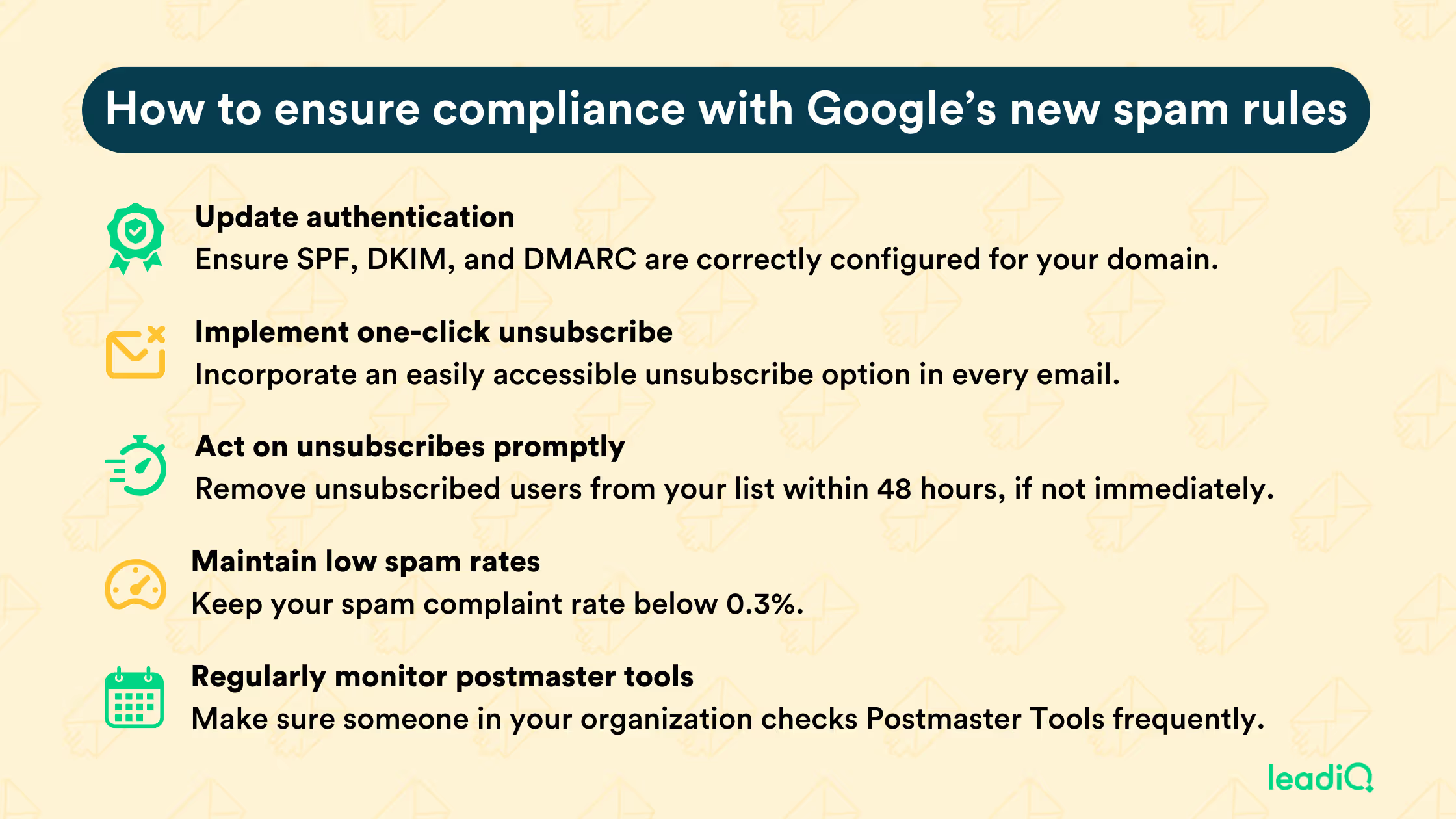Ready to create more pipeline?
Get a demo and discover why thousands of SDR and Sales teams trust LeadIQ to help them build pipeline confidently.



Organizations sending over 5,000 emails daily must adhere to new rules, including proper email authentication, easy unsubscribe options, and a low spam rate of under 0.3%.

Regularly monitoring Google Postmaster Tools is crucial to track spam rates, domain reputation, and email deliverability, ensuring compliance with Google's standards.

Email deliverability is a team effort. Sales, marketing, and other departments must work together to maintain a strong domain reputation and optimize outbound campaigns.
Get a demo and discover why thousands of SDR and Sales teams trust LeadIQ to help them build pipeline confidently.
Google’s new spam rules designed to enhance the user experience by keeping unwanted messages out of inboxes are officially on the books.
If your organization sends more than 5,000 emails each day, you need to pay attention because the new Google spam rules absolutely apply to you.
In case you’re unfamiliar, the rules require organizations to implement email authentication best practices, let users unsubscribe from mailing lists in one click, and remove those users within 48 hours. Additionally, companies also have to maintain a spam rate of less than 0.3% if they want messages to keep hitting inboxes.
To help people like you navigate the new rules successfully, we hosted a webinar featuring three outbound experts who shared their advice on how to prepare.
In it, Dave Rigotti, cofounder of Inflection.io and PLGTM.com, stressed the importance of checking Google Postmaster on a regular basis to monitor spam thresholds and ensure your domain doesn’t get blacklisted.
“If you don’t know your Google Postmaster score, go look it up — don’t assume that somebody is monitoring it,” Ricotti said. “There are a few numbers in Postmaster; the one you really want to look at is user-reported spam. Even if you’re not doing shady outbound, you should go check out your Postmaster score because you might be over the limit.”
We thought that great piece of advice deserved more ink.
Keep reading to learn how to use Google Postmaster Tools along with some cold email deliverability best practices that should help you keep your outbound efforts on track now that the new Google spam rules are in effect.
Fancy yourself an expert on Google Postmaster Tools? Here’s some more content you might find helpful as you adjust your strategy to prepare for the new spam rules:
Google Postmaster Tools is a free service provided by Google that gives domain owners and email senders the insights and data they need to monitor and improve email deliverability to Gmail users. It serves up various metrics and information related to email performance, spam complaints, authentication, and domain reputation within Gmail’s ecosystem.
Some of the key features you’ll find inside Google Postmaster Tools include:
Add it all up, and by making it a habit to check Google Postmaster Tools regularly, you can get the data you need to track cold email deliverability and proactively optimize your campaigns.
To access Postmaster Tools, you need to verify ownership of your sending domain. To do that, you can either visit the Google Postmaster website and sign into your account or ask someone from the technical support, product, or marketing team for an assist — whichever team is responsible for managing email deliverability and/or access. Once you’ve verified your domain, you’ll be able to access the above insights.
You might not be sending 5,000 emails a day as part of your outbound sales flows. But what about other departments? Recruiting, product, and marketing emails also count toward that 5,000 total — anything sent at the domain level counts, even password reset emails!
That being the case, sales and marketing teams need to monitor Postmaster Tools to ensure that campaigns reach the intended audience’s inboxes. By monitoring deliverability metrics — like inbox placement and spam complaint rates — you can assess the performance of your campaigns and identify issues that may be impacting deliverability.
Additionally, tracking authentication status and domain reputation can help your team maintain a positive sender reputation — something that’s crucial for ensuring that future emails are successfully delivered.
Bottom line? Monitoring Postmaster Tools helps sales and marketing teams optimize email strategies and maximize the impact of campaigns. Ultimately, maintaining a solid domain status is a team effort, requiring close coordination across your entire organization; the more folks who are keeping an eye on things, the better.

Getting the best results from your outbound campaigns starts with data. As you begin incorporating Postmaster Tools into your day-to-day, be sure to monitor the following five dashboards. By doing so, you can proactively identify and address any issues affecting cold email deliverability, improving the effectiveness of your efforts.
Monitoring your spam rate helps you measure how recipients perceive your cold emails and whether they’re being marked as spam. High spam rates can negatively impact your sender reputation and deliverability, leading to emails being filtered out or blocked by email providers.
Your IP reputation directly influences your email deliverability. Monitoring your IP reputation dashboard allows you to identify any issues that may be affecting your reputation — like being listed on spam blacklists or sending large volumes of unsolicited emails. Armed with that information, you can take corrective actions to improve your reputation.
Similar to IP reputation, your domain reputation plays a significant role in email deliverability. Monitoring your domain reputation dashboard helps you ensure that your sending domain has a positive reputation and is not associated with spam or malicious activity — both of which can impact cold email deliverability.
Are your emails even hitting inboxes? Monitoring delivery errors helps you identify any technical issues or errors that may be preventing your cold emails from reaching inboxes. Common delivery errors include DNS misconfigurations, SMTP errors, or mailbox full errors — all of which can hinder email delivery and engagement.
Email authentication protocols — like SPF, DKIM, and Domain-based Message Authentication, Reporting, and Conformance (DMARC) — help verify the authenticity of your emails and prevent spoofing and phishing attacks.
Monitoring authentication dashboards ensures that your email authentication settings are properly configured and that your emails are being authenticated successfully. This, in turn, improves deliverability and reduces the likelihood that emails are flagged as spam.
If you’ve got a ton of high-volume senders on your team, Rigotti suggests setting up subdomains for “air coverage” between departments.
Why this won’t help you get around these rules — Google counts everything sent from the root domain — you can add each subdomain to Postmaster Tools to make it easier to identify where increased spam complaints may be coming from, making it easier to fix potential problems.
For more tips on what you can do to thrive in the era of new Gmail spam rules and optimize cold email deliverability, watch the full webinar: The B2B sales guide to email deliverability and surviving Google’s spam rules update.